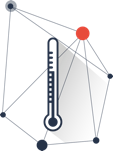
DH.GIS (District Heating Geographic Information System) is a GE Smallworld-based system designed for district heating companies. It is used in over 70 cities across Europe. DH.GIS supports key business processes in district heating companies, such as: maintenance, operation, investment planning or easement management. Recently we’ve enhanced the system with two new modules to extend its capabilities: Collisions and Technical Connection Conditions. Find out what features and benefits they bring!
Collisions
The module supports daily operations when handling outages and unexpected events in the field infrastructure. It also helps to coordinate the location of the designed land development networks, which are agreed upon at the meetings of the Documentation Arrangement Team.
The Collisions module draws data from GIS (Geographic Information System) and uses a graphic interface to present outages and objects on the map. It supports:
- alphanumeric (descriptive) and geometric (location of cases or objects) data
- attached photographs and documents, like agreements, Documentation Arrangement Team protocols, legal states, development maps, detailed drawings, notes etc
The main features of the module are:
- Full registration of cases and collisions with Documentation Arrangement Team with presentation on the map and attached documentation
- Automated reconciliation process
- Possibility to create reports and analyses
- Mobile access to the necessary documents during field tasks
The module guarantees many improvements to your company:
- Monitoring progress of implementation for all cases and collisions
- Instant access to full documentation when the collision’s place is indicated on the map
- Quickly find the location of the case or collision on the map based on Documentation Arrangement Team number
- Efficient identification of contractors or subcontractors of works
- Possibility of reporting damage to the network by the fieldwork contractor

Technical Connection Conditions
This module supports the procedures for joining/connecting new customers to the district heating network.
The customer’s location and information on the volume of supplies expected by the customer are crucial when issuing a grid connection decision. DH.GIS stores the technical data and the exact location of the district heating infrastructure components, so it can analyze the potential increase in power demand after the updated network layout and hydraulic and thermodynamic calculations have been made. This makes it easier to make quick decisions and determine the cost of connection.
This module, like the Collisions, draws information from the GIS system. The data can be visualized on the map. The module supports alphanumeric (descriptive), geometric (location) data and photographs and related documents (e.g. legal status, local plans, agreements, etc.).
The main features of the TWP module are:
- Registration of cases and accidents with Documentation Arrangement Team, together with presentation on the map and attached documentation
- Linking maps, data and documents in the process of arrangements with objects in the database and visualization of collision sites on the map
- Automation of the reconciliation process with the possibility of tracking their current status
- Creating links to real estate, plots and documents
Benefits
- All connection issues kept in one place
- Convenient control of deadlines and progress during customer’s connection
- Quick access to full documentation from the map
- Decisions on joining the new customers are based on real data and calculations

The TWP module is free of charge for all district heating companies using our DH.GIS system and having an active maintenance contract.
Sounds interesting?
Contact us – our experts will be happy to answer your questions.











